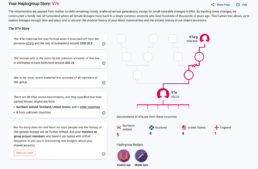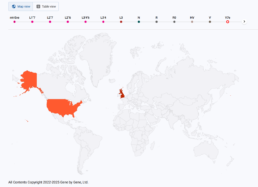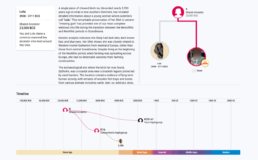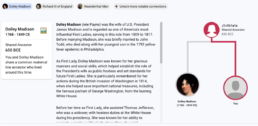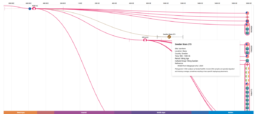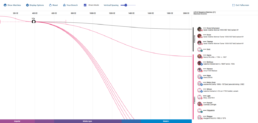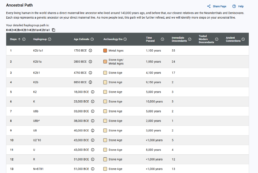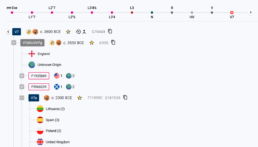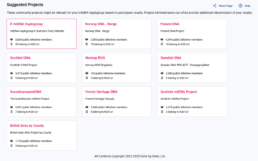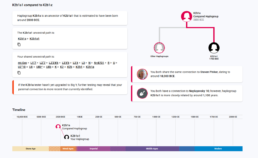By: Katy Rowe-Schurwanz
If you haven’t taken an mtDNA test yet, now is the perfect time to explore your maternal ancestry. FamilyTreeDNA’s mtDNA test provides the most detailed maternal lineage analysis available, allowing you to uncover deep ancestral roots, migration patterns, and DNA connections across generations. Learn more about mtDNA testing and start your journey today.
Meet mtDNA Discover—FamilyTreeDNA’s latest tool for maternal ancestry research. Explore your haplogroup’s history, migration routes, and DNA links to the past.
With the launch of the updated mtDNA Tree of Humankind, we’ve added a dozen new beta mtDNA reports to help you determine your ancestors’ origins and find connections with your matches.
- Haplogroup Story: Explore the history of your direct maternal lineage, from its ancient origins to modern-day connections.
- Country Frequency: See where your haplogroup is most commonly found today based on tester data and academic studies.
- Ancient Connections: Discover ancient individuals from your maternal line, identified through DNA from archaeological remains.
- Notable Connections: Find fun historical connections to well-known figures who share your haplogroup.
- Migration Map: Trace your maternal lineage’s migration from Africa to present-day locations, with insights from ancient DNA.
- Time Tree: View a time-scaled genetic tree that estimates when your maternal ancestors lived and how they connect to others.
- Match Time Tree (mtFull Exclusive): See how you and your mtDNA matches fit into a shared genetic tree, removing the guesswork in understanding relationships.
- Ancestral Path: Follow the genetic path of your maternal lineage, showing each step back to our common ancestor from 140,000 years ago.
- Classic Tree: Explore the full FamilyTreeDNA Mitotree, combining modern tester data with ancient and academic samples.
- Suggested Projects: Find community projects relevant to your haplogroup, where administrators can help interpret your results.
- Scientific Details: Dive deeper into the genetic science behind your haplogroup, including age estimates and the methodology used to build the updated mtDNA tree.
- Compare Haplogroups: See how any two haplogroups are related and estimate when their most recent common ancestor lived.
- Coming Soon! Globetrekker and Group Time Tree (mtFull Exclusive): Get ready for even more insights into your maternal ancestry!
Learn more about what each report can tell you about your direct maternal line, and how this information will help your family history research.
Haplogroup Story: An Overview of Your Maternal Lineage
The Haplogroup Story report provides a deeper look at your maternal lineage, from its ancient origins to modern-day connections. Learn when your haplogroup was formed with Age Estimates and how your matrilineal ancestors migrated across the globe over thousands of years. These insights help place your maternal ancestors within historical and geographic context.
Country Frequency: See Where Your Maternal Lineage is Found Today
The Country Frequency Map will show where your haplogroup is typically found today based on the Earliest Known Ancestor locations of testers who share your haplogroup.
This allows you to begin to pinpoint where your ancestors are from. By identifying where your haplogroup is commonly found, this report can:
- help confirm family stories
- guide historical research
- suggest regions to explore for maternal ancestors
The report is also animated, so you can watch the map become more specific over time as your haplogroup refines.
Switch to the Table view to see the list of countries displayed on the map and the number of tested descendants with matrilineal ancestors from this country who share your haplogroup.
It’s worth nothing, as the mtDNA Tree of Humankind grows, your Country Frequency map may change. This is because the data in this report is based on the number of testers in the tree.
Ancient Connections: Discover DNA Links to the Distant Past
With the Ancient Connections report you’ll receive a list of ancient DNA samples that share a common haplogroup ancestor with you.
Ancient DNA helps us connect the past to the present and uncover hidden links that are sometimes genealogically relevant, like what we’ve been able to do with the new L7 branch, a 100,000-year-old lineage discovered by our Million Mito Team, adding more depth to our collective human past.
For genealogists, these connections provide historical context for maternal ancestry, helping to validate deep lineage origins and identify migration patterns over time.
One great thing about mtDNA is that everyone has it. This means there are so many ancient mtDNA connections that can be added!
We’ll be adding new Ancient Connections frequently, so make sure you check back often to find new archaeological cousins!
Notable Connections: Discover Maternal Lineages Tied to History
Similar to Ancient Connections, there will also be many Notable Connections because everyone has mitochondrial DNA– with new ones added frequently! Notable Connections are famous historical or modern individuals whose haplogroup has been determined typically through DNA testing of matrilineal descendants, but in some cases, of the individual.
Many of these may not necessarily help you uncover genealogical answers—most will be fun trivia, like whether you shared a common ancestor a few thousand years ago with an actor, sports figure, or Wild West outlaw.
But sometimes, your connection can be much more recent and help prove genealogical connections. Many families have legends that they’re descended from a specific US president or a royal figure or clan. Thanks to DNA testing, many of those lineages have been proven.
You may match closely to that notable person and prove your connection. Or not match and disprove the connection.
For example, you may discover that you’re related to US First Lady Dolley Madison. FamilyTreeDNA collaborated with the Armed Forces DNA Identification Laboratory to identify unmarked graves of descendants of Samuel Washington, President George Washington’s brother. The study examined Y-DNA, mtDNA, and autosomal DNA, and one of the graves and mtDNA haplogroups identified belongs to Lucy Payne, sister of Dolley Madison.
Or you might discover that you’re related to Ludwig van Beethoven. Over his lifetime, Beethoven gifted locks of his hair to multiple friends. FamilyTreeDNA worked with a team of international scientists to identify which, if any, of the surviving eight locks belonged to Beethoven. Y-DNA, mtDNA, and autosomal DNA were all used in this study as well, and you might find your connection to Beethoven or the locks that turned out not to belong to him in Notable Connections.
Migration Map: Trace the Journey of Your Maternal Ancestors
Everyone will receive an expanded Migration Map showing where their ancestors branched off from Mitochondrial Eve in Africa and how those ancestors moved across and/or out of Africa. For genealogists, this report provides a starting point for identifying where to search for historical records, helping to trace maternal lineage movements over time and uncover potential ancestral homelands
The current Migration Map for your PhyloTree haplogroup stops at a basic haplogroup, typically around the Stone Ages. With the expanded map, you’ll be able to travel further and more recently in time and explore matching Ancient Connections.
Time Tree: See When Your Maternal Lineage Formed
The Time Tree is a genetic tree that places your mtDNA haplogroup on a time scale based on the preliminary FamilyTreeDNA Time To Most Recent Ancestor (TMRCA) Age Estimate.
The Age Estimates allow you to determine who your closest branch relatives are and when you share a common ancestor with them. For genealogists, this helps place maternal ancestors within a historical timeframe, offering insight into when and where a lineage branched off—providing clues for deeper research into historical events, migrations, and ancestral origins. The Time Tree can potentially even help you prove distant connections to where your ancestors were from and who they were.
You can see not just modern-day mtDNA testers on the tree but also Ancient and Notable Connections!
Match Time Tree: See How You and Your Matches Connect
The Match Time Tree goes a step further than the Time Tree, identifying your mtFull Sequence matches on the tree and adding their maternal Earliest Known Ancestors and Country of Origin.
The tree illustrates how you and your matches are related through your direct maternal lines of descent, based 100% on genetics. This removes the guesswork for understanding your mtDNA connections.
For genealogists, this report helps prioritize which matches may share a recent maternal ancestor, making it easier to focus on the most relevant connections for family history research. By understanding when a shared ancestor likely lived, you can narrow down records and collaborate with matches to uncover more about your lineage.
The new Match Time Tree shows your mtFull Sequence-tested mtDNA matches on your personal Time Tree, restricted to the relevant branches. This new feature is only available to mtFull Sequence testers.
Ancestral Path: Explore Your Maternal Line’s Deep Genetic History
The Ancestral Path report in Discover traces your haplogroup every step of the way back to Mitochondrial Eve and beyond to Neanderthal and Denisovan connections.
Your ancestral path starts at your assigned mtDNA haplogroup and goes back in time, one haplogroup step (or one genetic ancestor) at a time. For genealogists, this report provides a deeper understanding of how their maternal lineage evolved over time, showing how branches of their ancestry connect to major historical migrations and ancient populations.
Every step in the ancestral path has an age estimate based on the FamilyTreeDNA TMRCA algorithm, which provides an estimate of when the most recent common ancestor of everyone with this haplogroup lived.
You can also explore each step’s associated:
-
- archaeology era
- the number of years that passed between each step
- the number of branches of the mtDNA Tree of Humankind downstream of each step
- the number of modern testers and ancient connections that belong to it
Classic Tree: A Familiar, Interactive View of mtDNA Haplogroups
The Classic Tree will provide another view of the Mitotree, similar to a typical phylogenetic tree.
By default, it will show your portion of the Mitotree, along with:
-
-
- the countries of origin of each branch’s maternal Earliest Known Ancestor
- ancient DNA connections at each branch
- the associated archaeological era of each branch
-
Designed with functionality in mind, the Classic Tree is interactive, easy to navigate, and mobile-friendly. It provides a familiar phylogenetic layout for seasoned genetic genealogists while offering clear summaries of shared mutations and origin countries from mtFull Sequence testers.
You can collapse or expand different branches and view any part of the Mitotree, not just your own section.
You can find more information about how to read the new Mitotree in our Help Center.
Suggested Projects: Connect with Others Who Share Your Haplogroup
FamilyTreeDNA’s Group Projects allow you to collaborate with others who are researching in the same area as you, whether that’s a surname, geographic location, or a haplogroup. The Suggested Projects report will provide a list of Group Projects with members who have your same haplogroup.
Joining a project can help you collaborate with others researching the same lineage, compare results to identify patterns, and gain insights from experienced administrators who specialize in your haplogroup or ancestral region.
These Group Projects may be relevant to your genealogy and you can click on the Group Project’s name to learn more about it or join.
Scientific Details: Learn How Your mtDNA Results Are Calculated
The Scientific Details report allows you to learn more about the science behind your reports, including the Age Estimates.
During the beta period, the Age Estimates are considered preliminary and may change over time as our scientists continue refining the Mitotree structure. For genealogists, this report offers deeper insight into how haplogroups and Age Estimates are determined, helping to interpret results with greater confidence.
Compare Haplogroups: See How Two Maternal Lines Are Connected
The Compare Haplogroups tool allows you to take any two haplogroups and compare them to each other to find out how long ago they are related. For genealogists, this tool helps determine how closely two maternal lineages are connected, providing insight into shared ancestry even when haplogroups differ slightly.
This tool is really helpful when comparing mtDNA matches that have different haplogroups than you. Your Coding Region level mtDNA matches will all have the same Legacy mtDNA Haplogroup as you, the one based on the old PhyloTree.
However, because we’ve added so many more recent branches to the Mitotree, you may have matches who are related to you within a genealogical timeframe that are on a different branch of the Mitotree and have a different Updated mtDNA Haplogroup.
Coming Soon: New Tools to Explore Migration & Shared Lineages
We’ll continue adding more Ancient and Notable Connections and will soon add more reports, like Globetrekker and the Group Time Tree.
These upcoming tools will help genealogists visualize ancestral migrations (Globetrekker) and better understand connections within Group Projects (Group Time Tree), making it easier to collaborate on maternal lineage research.
In exciting news for our Group Project Administrators, soon we will add the ability for Administrators to view the Match Time Tree and Globetrekker reports for their Project members.
How to Access Your mtDNA Discover Reports
For customers who currently have mtDNA results, you can find a button for the new Discover reports under your mtDNA results section on your dashboard.
To get the most out of your mtDNA Discover reports, make sure you have filled out your maternal Earliest Known Ancestor information, including the location, under your Account Settings.
To gain more insight from all mtDNA Discover reports and get access to exclusive reports like the Match Time Tree (and the soon-to-come Globetrekker), take an mtFullSequence test today. Or sign in to add on or upgrade to the mtFull Sequence test if you’ve already tested with FamilyTreeDNA.
Learn More About mtDNA Discover and the Updated mtDNA Haplotree
We’ve added many useful articles to our Help Center, including pages for each of the mtDNA Discover reports, information about how to read the new Mitotree, and updated information for the mtDNA Matches page.
You can find more about the new Mitotree in our blog here.
Questions, concerns, and feedback can be directed to Customer Support.
You can also discuss the updates in the Mitochondrial DNA for Genealogy Facebook group, sponsored by DNA-Explain.

About the Author
Katy Rowe-Schurwanz
Product Manager at FamilyTreeDNA
Katy Rowe-Schurwanz has always been interested in genealogy, inspired by her maternal grandparents, who told her stories about their family and family history when she was little. After studying anthropology and history in college, she joined FamilyTreeDNA in 2015 and became the Trainer for Customer Support. Katy created and improved training processes and was fundamental in the creation of the Big Y Specialist team. In September 2021, she became Product Manager and has focused closely on improving FamilyTreeDNA’s genetic genealogy products.
